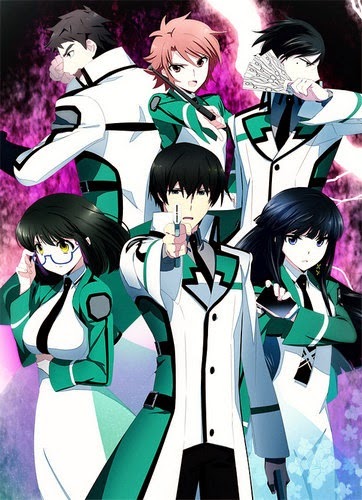 Mahouka Koukou no Rettousei, also called The Irregular at
Magic High School, or The Poor-performing at Magic High School, is obviously
about a high school full of students who can perform magic. The classes and student are split into those
who are exceptional at using magic (blooms) and those who can barely use magic
at all (weeds). The story follows a
brother and sister named Shiba Tatsuya and Shiba Miyuki. Miyuki is an exceptional magic user, and of
course, Tatsuya is a weed.
Mahouka Koukou no Rettousei, also called The Irregular at
Magic High School, or The Poor-performing at Magic High School, is obviously
about a high school full of students who can perform magic. The classes and student are split into those
who are exceptional at using magic (blooms) and those who can barely use magic
at all (weeds). The story follows a
brother and sister named Shiba Tatsuya and Shiba Miyuki. Miyuki is an exceptional magic user, and of
course, Tatsuya is a weed. As it turns out though, Tatsuya isn’t really inept at
magic. His magic is just so advanced and
different from the usual magic that he performs poorly on standardized magic
tests. Plus in addition to having pretty
amazing magic of his own, he’s a wizard at programming, especially programming
the CAD devices which are used by magic users to focus and amplify their magic
spells. They also hint along the way
that Tatsuya is not quite human, as he can reset himself when injured and has
very few human emotions, except for his feelings for Miyuki.
As it turns out though, Tatsuya isn’t really inept at
magic. His magic is just so advanced and
different from the usual magic that he performs poorly on standardized magic
tests. Plus in addition to having pretty
amazing magic of his own, he’s a wizard at programming, especially programming
the CAD devices which are used by magic users to focus and amplify their magic
spells. They also hint along the way
that Tatsuya is not quite human, as he can reset himself when injured and has
very few human emotions, except for his feelings for Miyuki.
The series is composed of three story arcs. The first arc deals with the siblings
entering the school and meeting their classmates. It also deals with the whole blooms/weeds
things and the inter-school prejudices, while introducing the cast and setting
the stage. Tatsuya is quickly found to
be much more than he seems and he and Miyuki quickly become involved in the school, with Miyuki becoming a member of the
Student Council and Tatsuya becoming a member of the Student Disciplinary Committee.
The second arc covers a multi-school magic competition and
not only do both Miyuki and Tatsuya compete in the various “games”, but Tatsuya
ends up doing the programming for most of their school’s students’ CADs. In the end he also foils a lot of plots
intended to keep their school from winning the competition, which they do
win. In the final battle game, Tatsuya
is accidentally killed by the top student of one of the other magic schools, who
also happens to be the next head of one of the most powerful of the Ten Master Clans. Tatsuya uses his most powerful
magic skill, and regenerates himself instantly, so no one knows he should be
dead, although most everyone is amazed he didn’t die.
 The final arc involves an attack on the magic users during
another competition between the magic schools.
During this final arc, Tatsuya,
Miyuki and the magic-using students demonstrate clearly that magic-using
warfare beats normal, mechanical warfare all hollow. In addition, Tatsuya’s spell which allows him
to reset himself, allows him to reset others also, both people and things, if
he gets to them within 24 hours of the damage.
He saves a couple of students’ lives
this way.
The final arc involves an attack on the magic users during
another competition between the magic schools.
During this final arc, Tatsuya,
Miyuki and the magic-using students demonstrate clearly that magic-using
warfare beats normal, mechanical warfare all hollow. In addition, Tatsuya’s spell which allows him
to reset himself, allows him to reset others also, both people and things, if
he gets to them within 24 hours of the damage.
He saves a couple of students’ lives
this way.
Despite those two issues, the story was interesting enough
to keep me watching. Or maybe I kept
watching to try to figure out exactly what Tatsuya is. His family is not very happy with his
existence and tends to ignore him for the most part, except for Miyuki who
worships him. He is also a secret
operative for a special magic-using section of the JSDF. Plus his magic and computer abilities often
seem more than human.
 I ended up not
getting all (any) of my questions answered.
Like why does Miyuki control Tatsuya’s powers? Before the final battle, she releases the
limiter on his powers. So, the series ended abruptly with a lot of things up in
the air, including with me having the same question I watched the series all the way
through in order to find the answer to: Who or
What is Tatsuya? Still . . .
I’m glad I watched it, although I probably won’t watch another season if
they continue it.
I ended up not
getting all (any) of my questions answered.
Like why does Miyuki control Tatsuya’s powers? Before the final battle, she releases the
limiter on his powers. So, the series ended abruptly with a lot of things up in
the air, including with me having the same question I watched the series all the way
through in order to find the answer to: Who or
What is Tatsuya? Still . . .
I’m glad I watched it, although I probably won’t watch another season if
they continue it. 











































11-05-15%5D.jpg)








